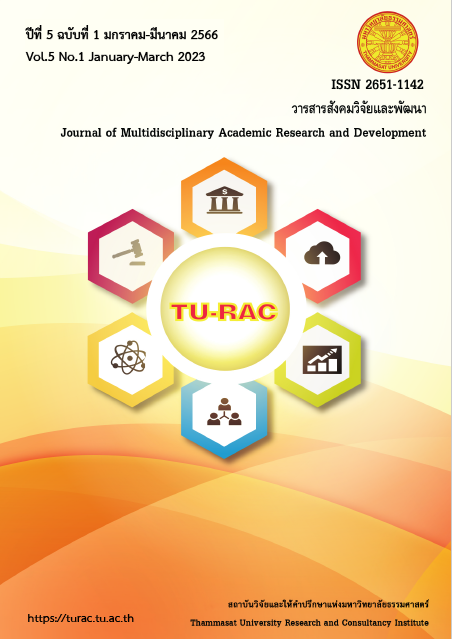Constructing a Cyberbullying Scale for Undergraduates
Keywords:
Scale, Cyberbullying, National norms, Normalized t-scoreAbstract
This article aimed to 1) synthesize components and indicators of cyberbullying; 2) verify accuracy of scale measurements; and 3) establish cyberbullying scale norms for undergraduates. 960 samples were undergraduates during the academic year 2021, chosen by multistage sampling with the Likert scale. Data was statistically analyzed for content validity, discriminating power, construct validity by second order confirmatory factor analysis (CFA) by the Mplus program, and to identify a normal T-score. Results were that 1) the cyberthreat scale consisted of three components, nine indicators, and 39 questions; 2) the cyberaggression indicator had an index of conformance (IOC) of 0.60 – 1.00 power of discrimination, the first time between .425 - .880 and the second between .665 - .912, with whole copy reliability of .992; the correlation coefficient was between .482 - .848, component weight between 0.677 – 0.991 and statistically significant at .05 for all indicators; the model consistency index consisted of the statistical value chi-square = 30.341, p-value = 0.065, comparative fit index (CFI) = .994, Tucker-Lewis Index (TLI) = .989, root mean square error of approximation (RMSEA) = .046 and standardized root mean squared residual (SRMR) = .019, indicating that the corroborative component analysis model of the cyberbullying model for undergraduates was structurally coherent and consistent with empirical data; 3) The national norm measurement was mean = 61.07, S.D. = 19.17, with a percentile rank score range of 0.2-100.0, and normalized T-score range of 21 – 89.
References
ณัฐฐา วินิจนัยภาค. (2560). ทัศนคติของเด็กและเยาวชนไทยต่อพฤติกรรมการกลั่นแกล้งบนโลกไซเบอร์. สืบค้นเมื่อวันที่ 29 กรกฎาคม 2564 จาก https://nidapoll.nida.ac.th/data/survey/uploads/FILE-1603871940213.pdf.
ณัฐรัชต์ สาเมาะ. (2556). การรับรู้ของเยาวชนต่อการรังแกในพื้นที่ไซเบอร์. (วิทยานิพนธ์ปริญญามหาบัณฑิต). มหาวิทยาลัยมหิดล, สังคมศาสตร์การแพทย์และสาธารณสุข.
ธันยากร ตุดเกื้อ. (2557). การพัฒนาตัวบ่งชี้พฤติกรรมการรังแกบนโลกไซเบอร์ของเยาวชนในจังหวัดสงขลา. (วิทยานิพนธ์ปริญญามหาบัณฑิต). มหาวิทยาลัยสงขลานครินทร์, สาขาวิชาพัฒนามนุษย์และสังคม.
นงลักษณ์ วิรัชชัย. (2542). โมเดลลิสเรล: สถิติวิเคราะห์สําหรับการวิจัย. พิมพ์ครั้งที่ 3. กรุงเทพฯ: จุฬาลงกรณ์มหาวิทยาลัย.
นัทธมน ทับทิมไทย. (2563). อิทธิพลของความรู้เกี่ยวกับพระราชบัญญัติว่าด้วยการกระทำความผิดเกี่ยวกับคอมพิวเตอร์ที่มีต่อพฤติกรรมการกลั่นแกล้งทางอินเทอร์เน็ตของนักเรียนระดับมัธยมศึกษาในจังหวัดชลบุรี. (วิทยานิพนธ์ปริญญามหาบัณฑิต). มหาวิทยาลัยบูรพา, สาขาวิชาวิจัย วัดผลและสถิติการศึกษา.
รัตติยา ดีน้ำจืด. (2560). พฤติกรรมการรังแกผ่านโลกไซเบอร์ของนักเรียนระดับชั้นมัธยมศึกษาตอนปลาย. (วิทยานิพนธ์ปริญญามหาบัณฑิต). มหาวิทยาลัยบูรพา, คณะรัฐศาสตร์ สาขาวิชาการบริหารงานยุติธรรมและสังคม.
ล้วน สายยศ และ อังคณา สายยศ. (2543). เทคนิคการวัดผลการเรียนรู้. (พิมพ์ครั้งที่ 2). กรุงเทพฯ: สุวีริยาสาสน์.
ศิวพร ปกป้อง และ วิมลทิพย์ มุสิกพันธ์. (2553). ปัจจัยที่มีผลต่อทัศนคติและพฤติกรรมการกระทำความรุนแรงทั้งทางกายภาพและการข่มเหงรังแกผ่านโลกไซเบอร์ของเยาวชนไทย. กรุงเทพฯ: มหาวิทยาลัยมหิดล.
สำนักงานคณะกรรมการการอุดมศึกษา. (2564). สถาบันอุดมศึกษา. สืบค้นเมื่อวันที่ 8 พฤศจิกายน 2564, จาก http://www.mua.go.th/university-2.html.
สำนักงานสถิติแห่งชาติ. (2563). ผลการสำรวจการใช้เทคโนโลยีสารสนเทศและการสื่อสารในครัวเรือน พ.ศ. 2563. สืบค้นเมื่อวันที่ 16 มิถุนายน 2565, จาก http: //www. nso.go.th/sites/2014/Pages/สำรวจ/เทคโนโลยีสารสนเทศ/การใช้ICTของเด็กและเยาวชน.aspx.
สถาบันแห่งชาติเพื่อการพัฒนาเด็กและครอบครัว. รู้หรือไม่ 59% ของเด็กไทยเคยเป็นส่วนหนึ่งใน Cyberbullying. สืบค้นเมื่อ 8 พฤศจิกายน 2564, จาก https://www.eventpop.me./blog/200-cyberbullying,2019.
อนุพงศ์ สุขเกษม. (2563). พฤติกรรมและเจตคติต่อการระรานทางไซเบอร์ของนักเรียนระดับชั้นมัธยมศึกษาในกรุงเทพมหานคร. วารสารจันทรเกษมสาร. 26(2), 297-313.
Carroll, J. (2006). Bush uses bully pulpit to promote transparency. Managed Care (Langhorne, Pa.), 15(10), 12-13.
Donegan, R. (2012). Bullying and cyberbullying: History, statistics, law, prevention and analysis. The Elon Journal of Undergraduate Research in Communications. 3(1), 33-42.
Downloads
Published
How to Cite
Issue
Section
License
Copyright (c) 2023 ราชัน ทวีคณะโชติ, นันทิมา นาคาพงศ์ อัศวรักษ์

This work is licensed under a Creative Commons Attribution-NonCommercial-NoDerivatives 4.0 International License.



